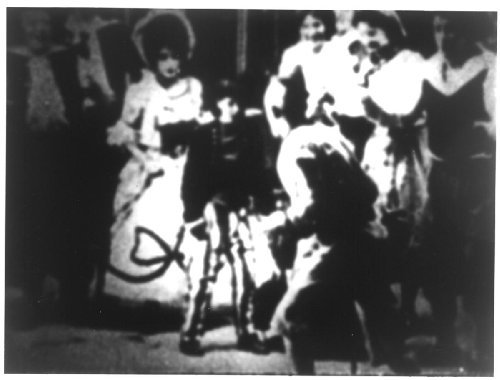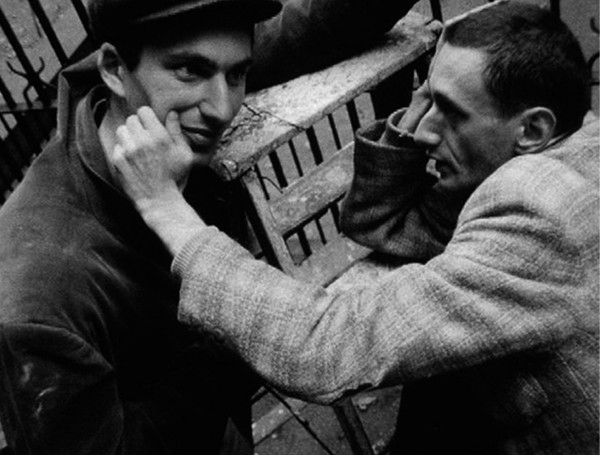
Ken Jacobs, via Kill Your Timid Notion
Ken Jacobs’ body of work forms a veritable catalog of underground trends in American cinema since the 1950s: anarchic, DIY filmmaking (Little Stabs of Happiness [1960], Blonde Cobra [1963]); structural cinema (Tom, Tom, the Piper’s Son [1969]); performances expanding and subverting the conventional cinematic apparatus (the Nervous System and Nervous Magic Lantern performances); and category-defying found footage epics (Star Spangled to Death [1956-1960, 2001-2004]). Jacobs has been at the center of the avant-garde not only as a creator but also as a facilitator and influence, collaborating with filmmaker and performer Jack Smith on several important projects, co-founding the Millennium Film Workshop, and teaching students — many of whom have gone on to remarkable cinematic careers in their own right — in the pioneering film program at Binghamton University. To say Optic Antics, the first book devoted entirely to the films of Ken Jacobs, is long overdue would constitute a gross understatement.
Editors Michele Pierson, David E. James, and Paul Arthur have assembled for Optics Antics a wide array of essays in order to understand Jacobs from multiple, often surprising angles. There are, of course, several attempts at grappling with the conceptual core of Jacobs’ oeuvre, which is as thoroughly invested in exploring uncharted areas of technological innovation and visual stimulation as it is in unmasking the political ramifications of cinematic illusionism: Eivind Røssack’s “Acts of Delay: The Play Between Stillness and Motion in Tom, Tom, the Piper’s Son,” Pierson’s “Jacobs’ Bergsonism,” and Federico Windhausen’s “Theories of Moving Pictures: Ken Jacobs after Hans Hoffman” each discuss Jacobs as investigator and orchestrator of cinematic movement, time, and space. But considering the often ineffable and intensely experiential nature of much of Jacobs’ work, many of the essays in Optic Antics opt for personal or impressionistic approaches, as with Jonas Mekas’ “Texts on Ken Jacobs” and Art Spiegelman’s comic strip insert about his and Jacobs’ three-decade friendship. Also included are “Some Jacobs Family Photos” by Flo Jacobs, Ken’s wife of fifty years, and Amy Taubin’s interview with Flo, who’s served as collaborator, archivist, and unofficial “producer” (as Taubin suggests) of her husband’s projects and performances.

Tom, Tom, The Piper’s Son (1969), dir. Ken Jacobs
Much like a Jacobs film — his best known and most celebrated work, Tom, Tom, deconstructs a 1905 short film through freeze-frame, slow-motion, enlargement, etc. — Optic Antics first orients the reader with an introductory overview of the filmmaker’s life and work before plunging headlong into their complexities. The late Paul Arthur — who tragically died midway through the production of Optic Antics — fittingly gets the first word with “‘A Panorama Compounded of Great Human Suffering and Ecstatic Film Representation’: Texts on Ken Jacobs.” Providing a survey of Jacobs’ major works, “A Panorama” describes the filmmaker as consistently “[a]rmed with a staunch aversion to ‘order and determination.’” Arthur carefully details many of Jacobs’ strategies, ranging from the instructions to intermittently play live radio broadcasts during Blonde Cobra to his use, in his Nervous System performances, of dual projectors capable of advancing identical prints of the same film frame by frame in order to produce “uncanny three-dimensional space illusions.” Arthur encapsulates the otherworldly yet concrete effect of Jacobs’ cinema, a carefully constructed array of reappropriated detritus perpetually threatening to totter into chaos: “Lurking at the edges of Jacobs’ myriad improvised, rehearsed, or aleatory maneuvers is an impossible pursuit of presentness in the screened image, which is, for him, always ripe with time, with oscillating layers of past and present. His trashing of linearity summons a temporal realm that is often surprisingly historical in effect, but can nonetheless yield an apocalyptic scent of something beyond time — a secular, machine-made version of eternity.”
Some of the best essays in the anthology cast light on the more obscure works of Jacobs’ career. In “Film as an Instrument of Thought, Cinema as an Augury of Redemption,” David E. James draws attention to the belatedly distributed and rarely seen The Sky Socialist (1964-1968), in which Jacobs makes metaphorical use of Anne Frank and Isadore Lhevinne — the latter an obscure Russian author of erotically delirious surrealism — in order to concoct a ramshackle, diasporic melodrama. James argues that Frank and Lhevinne, though very different writers, ultimately stand for similar Jewish experiences of persecution in the 20th Century; Jacobs stages their convergence against the Brooklyn Bridge, evoking both the structure’s roots in progressive and democratic architectural principles and, relatedly, its enduring resonance in, and inspiration for, constructivist and populist art. With typical depth and insight, James discovers an almost messianic impulse to create a utopia from discarded elements of reality, an impulse that cuts across much of Jacobs’ work.

Nervous Magic Lantern Performance by Ken Jacobs
Because of the proximity of the writers to their subjects, a few Optic Antics essays cover in detail the contentious battles that Jacobs has been embroiled in over the years. Larry Gottheim writes about the tension between Jacobs and Nicholas Ray when the two filmmakers were fellow professors in the upstart Binghamton program. And he should know: Gottheim was chair of the department. Similarly involved in the events he describes, Scott MacDonald gives an account of the volatile reception given to Jacobs’ Nervous System performance of XCXHXEXRXRXIXEXSX (1980) at the 1992 Robert Flaherty Film Seminar. MacDonald programmed two days of the seminar, and included Jacobs’ performance for intentionally combative purposes; feminists in the Flaherty audience took particular exception to XCXHXEXRXRXIXEXSX, which stretches and reclaims a piece of vintage cinematic pornography. Beyond the (not inconsiderable) entertainment value of such intellectual fisticuffs, these pieces provide a front-row seat to the artistic and political conflicts of their times: the adventurousness that brought the avant-garde to higher learning in the late-Sixties and early-Seventies, and the dominance of sexual and gender politics in the art world of the early Nineties.
Given the breadth and diversity of Jacobs’ output, Optic Antics only gestures at comprehensiveness. Considering the amount of time and energy Jacobs put into it — as well as its Goliath of a subject (the nightmares barely concealed within America’s endless pop charade) and its enormous duration (seven-plus hours) — his movie Star Spangled to Death receives only brief, intermittent mentions in Optic Antics. And although in their respective essays Branden W. Joseph and Tony Pipolo both touch on the significance of Jack Smith to Jacobs and the haunting after-image he leaves behind in several films, an essay exploring the watershed team-up of these two “film-mad” misfits would have been most welcome.

Star Spangled to Death (2004), dir. Ken Jacobs
Nonetheless, Optic Antics performs a superlative job of covering a world essential to avant-garde history — and the history of movies, period — for not only bridging explicit politics and radical aesthetics but also for allowing audiences to see the cinematic objects of the past through the artistic practices of the future: in other words, for allowing us to see anew. Featuring studies and reactions physical, cerebral, political, and cosmic, Optic Antics inspires along the lines of Jacobs’ own professorial advice about experiencing and responding to cinema: “Get lost. And get lost again.”
]]>